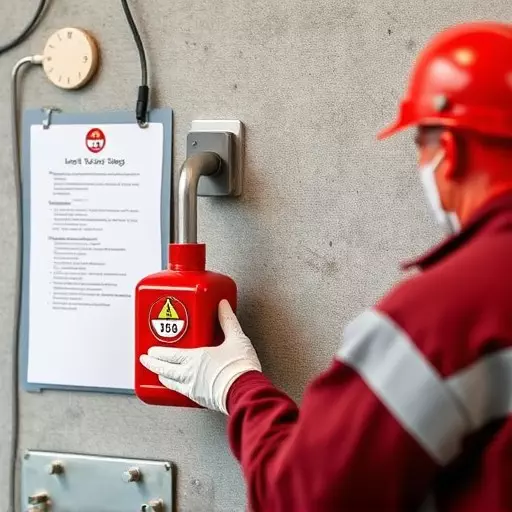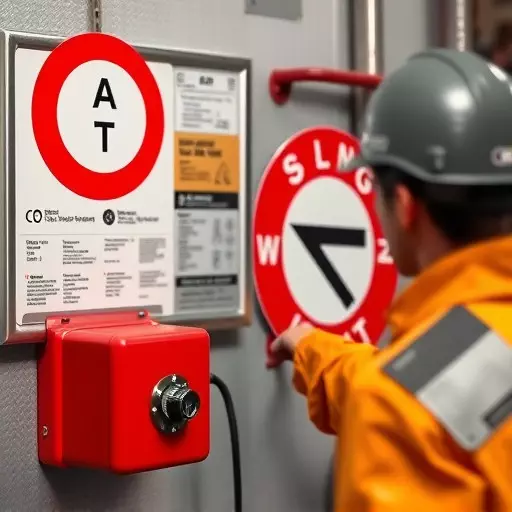Safeguarding workplace safety is a paramount concern within the manufacturing sector. A critical aspect of this safety net is the implementation and adherence to lockout tagout (LOTO) compliance protocols. This article delves into the intricacies of LOTO compliance training, shedding light on its indispensable role in maintaining a secure environment for workers. We will explore the comprehensive OSHA lockout tagout standards, highlighting their regulatory requirements that form the backbone of energy control procedures training. By examining key components of effective LOTO compliance programs and offering best practices for conducting training sessions, this article aims to provide manufacturers with practical insights on implementing these lifesaving measures. Through case studies, we will demonstrate real-world applications and the tangible benefits of robust LOTO compliance training in enhancing manufacturing safety.
- Understanding Lockout Tagout (LOTO) and Its Importance in Manufacturing Safety
- OSHA Lockout Tagout Standards: An Overview of Regulatory Requirements
- The Role of Energy Control Procedures in Lockout Tagout Compliance Training
- Key Components of Effective Lockout Tagout Compliance Training Programs
- Practical Implementation of LOTO Procedures in Manufacturing Environments
- Best Practices for Conducting Energy Control Procedures Training Sessions
- Case Studies: Real-World Applications and Benefits of LOTO Compliance Training in Manufacturing Safety
Understanding Lockout Tagout (LOTO) and Its Importance in Manufacturing Safety
Lockout Tagout (LOTO) is a safety-related work practice that comprises specific procedures, devices, and equipment for preventing unintended energy release while machinery or equipment is under repair or maintenance. Understanding LOTO compliance training is crucial for maintaining a safe working environment within the manufacturing sector. It ensures that all personnel are aware of how to properly apply, use, and remove energy control devices in order to safeguard themselves and their coworkers from hazardous energy sources. This understanding is not just a procedural necessity but an essential part of fostering a culture of safety within the facility.
The Occupational Safety and Health Administration (OSHA) has established stringent lockout tagout standards to govern the application of LOTO in workplaces where the unexpected energization or start-up of equipment, or release of stored energy, could occur. These standards mandate that employees receive comprehensive training on the appropriate energy control procedures. This is where specialized LOTO compliance training programs become indispensable. They equip workers with the knowledge and skills to apply LOTO effectively, thereby preventing accidents and mitigating risks associated with unexpected machine movement or activation. Employers must ensure that all employees involved in maintenance activities are trained to competently implement these energy control procedures, thus upholding the integrity of safety protocols within manufacturing environments. Proper training not only aligns with regulatory requirements but also underscores a commitment to worker health and operational efficiency.
OSHA Lockout Tagout Standards: An Overview of Regulatory Requirements

The Occupational Safety and Health Administration (OSHA) has established comprehensive Lockout Tagout (LOTO) standards to safeguard employees from hazards associated with energy sources during maintenance, repair, or any other operation that could inadvertently energize machinery or equipment. These standards are critical in preventing unplanned machine start-ups or unexpected release of stored energy, which could result in severe injury, equipment damage, or both. Employers must adhere to OSHA’s LOTO compliance training requirements to ensure their workforce is proficient in the use of energy control procedures. This training encompasses recognizing potential energy sources, implementing appropriate lockout tagout devices, and understanding the significance of proper communication among employees during energy isolation processes. The OSHA lockout tagout standards mandate that each employee who performs hazardous work must be trained in and understands the energy control program applicable to their specific workplace. This ensures that each individual is aware of the procedures for applying the energy-isolating devices, including lockout devices and tagging systems, to prevent unexpected energization and release of stored or residual energy. Proper training is not just about meeting regulatory requirements; it’s an integral component of a safe work environment, reducing the risk of accidents significantly. Compliance with these standards is essential for any manufacturing operation where machines or equipment are serviced, maintained, or repaired.
The Role of Energy Control Procedures in Lockout Tagout Compliance Training

Lockout tagout (LOTO) compliance training is a critical component in ensuring worker safety in manufacturing environments. It involves the use of specific devices and procedures to control hazardous energy, thereby preventing unexpected energization or start-up of machinery and equipment, which could result in injury or fatality. A key element within LOTO compliance training is the emphasis on energy control procedures (ECPs). These procedures are detailed steps that workers must follow to safely isolate, control, and dissipate energy during the maintenance and repair of machines.
Understanding OSHA’s lockout tagout standards is paramount for effective LOTO compliance training. The standards set forth by OSHA guide the development of ECPs training programs. These training sessions are designed to equip workers with the knowledge and skills necessary to apply ECPs correctly. Through hands-on demonstrations, practical exercises, and real-world scenarios, trainees learn how to properly apply locks, tags, or other devices to isolate equipment from all forms of energy sources. This ensures that when a worker is servicing or maintaining a machine, it remains safely deenergized, thereby preventing the release of hazardous energy and mitigating the risk of accidents. ECPs training goes beyond theoretical knowledge; it empowers workers to apply best practices and adhere to safety protocols, making LOTO compliance a cornerstone of workplace safety in the manufacturing sector.
Key Components of Effective Lockout Tagout Compliance Training Programs

Practical Implementation of LOTO Procedures in Manufacturing Environments

Best Practices for Conducting Energy Control Procedures Training Sessions

Ensuring compliance with OSHA’s lockout tagout standards is paramount for maintaining a safe and efficient manufacturing environment. To achieve this, robust training in energy control procedures is indispensable. The training sessions should not be a mere formality but must incorporate interactive and practical demonstrations to reinforce the concepts taught. Employers must train workers on the particular energy control procedures relevant to their jobs, enabling them to apply the lockout tagout compliance training effectively in real-world scenarios. This hands-on approach facilitates a deeper understanding of how to properly use energy-isolating devices and implement the necessary steps to safely control, isolate, and dissipate energy. Additionally, it is crucial that the training includes theoretical knowledge coupled with practical exercises, ensuring that each participant can recognize, apply, and secure machinery and equipment in a manner consistent with OSHA lockout tagout standards. The training should be conducted by qualified instructors who can provide clear explanations, demonstrate correct techniques, and answer any questions to clarify doubts. Regularly updating the content of these sessions to reflect changes in regulations or industry best practices will further enhance worker safety and compliance.
Case Studies: Real-World Applications and Benefits of LOTO Compliance Training in Manufacturing Safety

In the realm of manufacturing safety, adherence to lockout tagout (LOTO) compliance training is paramount in mitigating the risks associated with unexpected energy resurgences during maintenance and repair tasks. Real-world case studies consistently demonstrate the efficacy of rigorous LOTO compliance training programs. For instance, a notable manufacturing facility implemented an OSHA-aligned LOTO compliance training regimen, which led to a marked decrease in accidents involving unexpected machinery restarts. This initiative not only safeguarded workers but also streamlined production processes by fostering a culture of safety and reliability. The training emphasized the critical steps of identifying energy sources, applying appropriate devices, and creating clear and understandable labels to communicate the status of equipment. By integrating OSHA’s lockout tagout standards into their energy control procedures training, employees developed a keen awareness of the potential hazards and were equipped with the knowledge and tools necessary to work confidently and safely around machinery. This heightened awareness has proven to be a significant deterrent against workplace accidents, ensuring that equipment is properly isolated, thereby preventing unintended start-ups and reducing the risk of injury or fatality.
Furthermore, the benefits of LOTO compliance training extend beyond incident prevention; they also contribute to a more efficient workflow. A study conducted at a large manufacturing plant highlighted how standardized LOTO procedures reduced downtime by facilitating quicker and safer maintenance. The training enabled workers to identify and rectify potential energy hazards promptly, which in turn minimized production delays. This case underscores the importance of integrating OSHA’s lockout tagout standards into a comprehensive safety program. By providing employees with the competencies needed to effectively implement energy control procedures, manufacturers can create a safer work environment while maintaining productivity and operational efficiency. The integration of LOTO compliance training is thus not just a regulatory requirement but a strategic investment in safeguarding human life and preserving the integrity of manufacturing operations.


